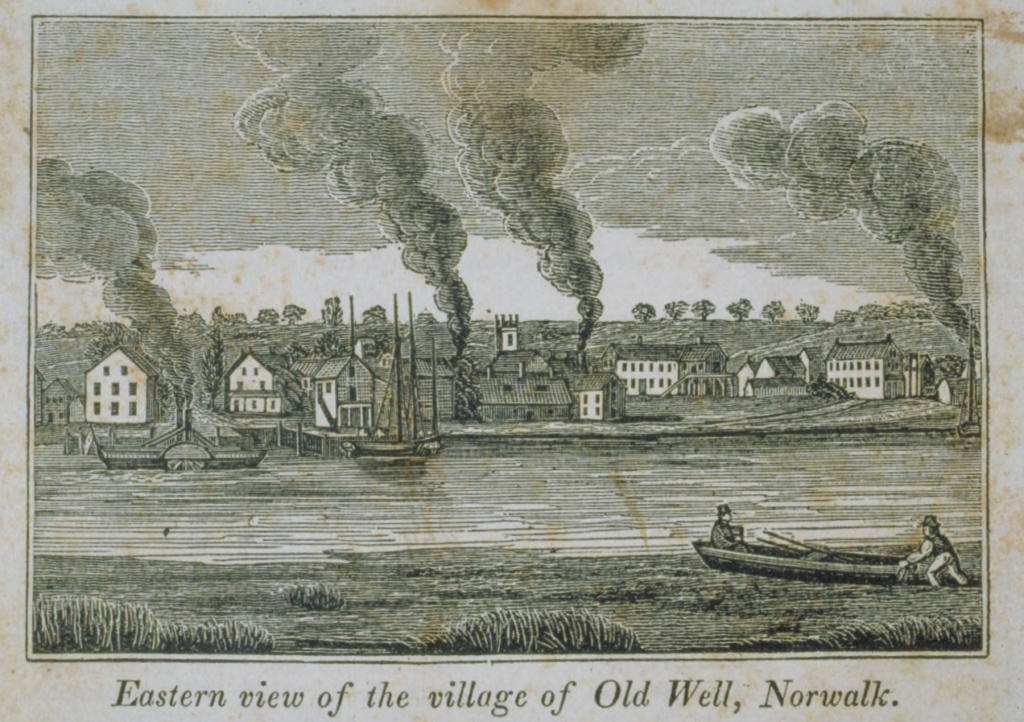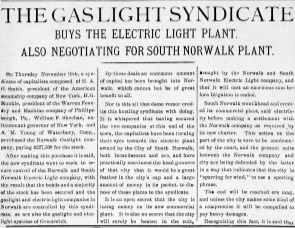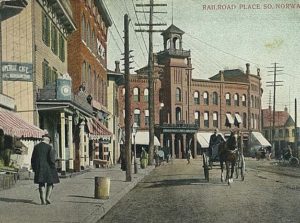By Edward T. Howe
The first municipal electric plant in Connecticut began operating in the City of South Norwalk in 1892 to provide low-cost electricity for street lighting and, a few years later, for homes and businesses. Four more municipalities acquired their own facilities between the end of the 19th and early 20th centuries. In 1976 a wholesale power supply system was created that would serve the needs of both municipal electric utilities and other participants.
South Norwalk, located in the southwestern part of the state on Long Island Sound, was known in the 18th century as “Old Well.” Its economy centered on farming, shipbuilding, crafts, shellfish, and coastal trade. During the 19th century it industrialized, with factories providing woolen goods, locks and keys, shoes, and hats. As it prospered, Old Well formally became the City of South Norwalk – within the town of Norwalk – in 1870.
Gas-Lighting in Connecticut
Gas for lighting purposes, at least that offered by private firms, had been evident in Connecticut since at least the mid-19th century. However, a new source of illumination appeared in Hartford in 1882 when a private electrical generating plant began operating. Meanwhile, the first municipal electric plant in the nation opened in Fairfield, Iowa in the same year.
Although small investor-owned electric facilities quickly spread across Connecticut, it took a decade before the first municipal electric plant opened in the state. The rationale for the plant can be traced to 1887 when two private firms – the Norwalk Gas Light Company and the Norwalk and South Norwalk Electric Light Company – were authorized to sell electricity. Although they initially competed, the Norwalk Gas Light Company sold its electrical assets to the latter company on February 8, 1892, creating a monopoly.
Critics in South Norwalk complained, even before the monopoly was created, that the cost of street lighting was too high and the service undependable. Finding that their complaints went unheeded by the electric company, a citizens group proposed municipal ownership of a generating plant as a not-for-profit alternative. The monopoly argued that the proposed plant could not be built for the appropriated amount and, if constructed, not capable of being operated at its estimated outlays. Nevertheless, city residents approved a bond issue of $22,500 for construction of the municipal electric plant – the first such facility in Connecticut.
On October 13, 1892 the plant (South Norwalk Electric Works) began operating, but only to supply street lighting. The original electric installation had an iron chimney, one horizontal tubular boiler, a 100 horsepower steam engine (with diesel oil engines installed after 1905), a feed water heater, a pump, an injector, all necessary piping, two 60 light arc dynamos, a switch-board, all necessary electrical appliances, tools, office fixtures, and a pole line system supplying 86 arc lamps. In 1897 an addition to the plant was approved for commercial lighting (homes and businesses), with service beginning on August 1, 1898. As with street lighting, a flat rate system for service was initially used, but the firm switched to a meter system for all services in 1903. Commercial demand for electric service was so great that the plant had to be enlarged six times between 1892 and 1910.
Meanwhile, the East Norwalk Fire District (created in 1894) was authorized by the state legislature in 1906 to maintain sewers and light the streets. In 1908 it created its electric substation and bought its electricity from the South Norwalk plant for street lighting. It built its own generating facility in 1914, negating the need for electricity from the South Norwalk plant.
Norwalk Consolidates
In 1913 the City of Norwalk was incorporated by consolidating the cities of South Norwalk and Norwalk, the East Norwalk Fire District, and the remaining portions of the surrounding town of Norwalk. After the consolidation, the city of South Norwalk became the Second Taxing District and the East Norwalk Fire District became the Third Taxing District. Each taxing district retained ownership and operation of its electric plants. Since the Second Taxing District also retained ownership of its water facilities, it formed a new entity – South Norwalk Electric and Water.
An 1893 law authorizing gas and electric plants for cities, towns, and boroughs encouraged other municipalities to construct their own facilities. Consequently, electric utilities were established in the Boroughs of Jewett City in 1897, Wallingford in 1899, Groton in 1904, and the City of Norwich in 1904. Bozrah Power and Light Company, originally a private firm, was bought by the City of Groton in 1995 and became a wholly-owned subsidiary. As with South Norwalk, these utilities own their retail distribution facilities (poles and wires connected to homes and businesses). They are governed by elected or appointed commissioners regarding their financial condition and operations.
Faced with the need to purchase increasingly expensive electric power from investor-owned firms, three municipal utilities – Groton, Jewett City, and Norwich – formed the Connecticut Municipal Electric Energy Cooperative (CMEEC) in 1976. Over time, the other municipal electric utilities joined the wholesaler – including South Norwalk Electric and Water on March 1, 1988. Located in Norwich, this member-directed wholesale supplier has continued to provide low-cost electric power from various sources to its municipal owners and other participants who, in turn, have distributed it to their residential, commercial, industrial, and business customers.
Edward T. Howe, Ph.D., is a Professor of Economics, Emeritus, at Siena College near Albany, New York.











